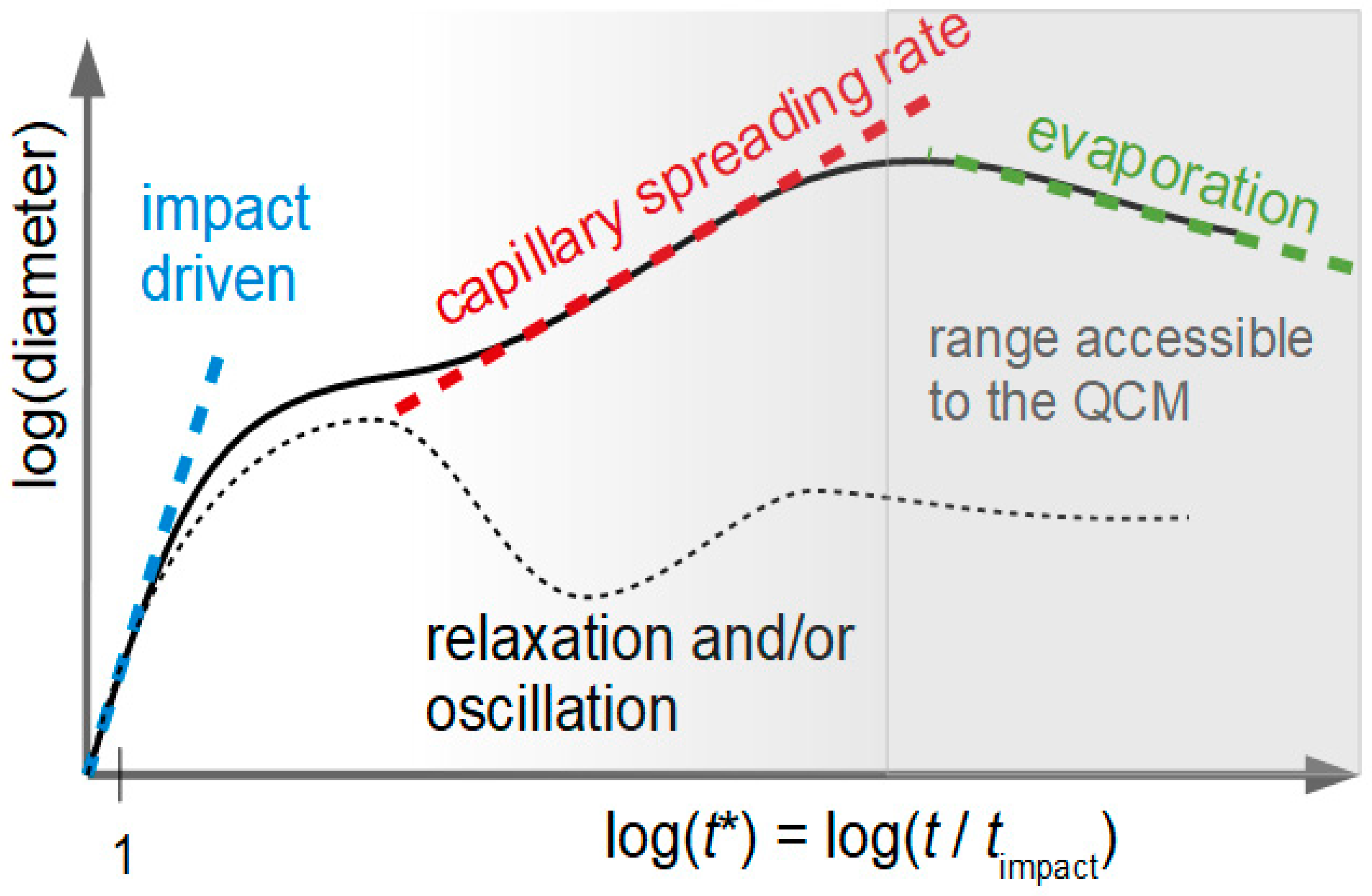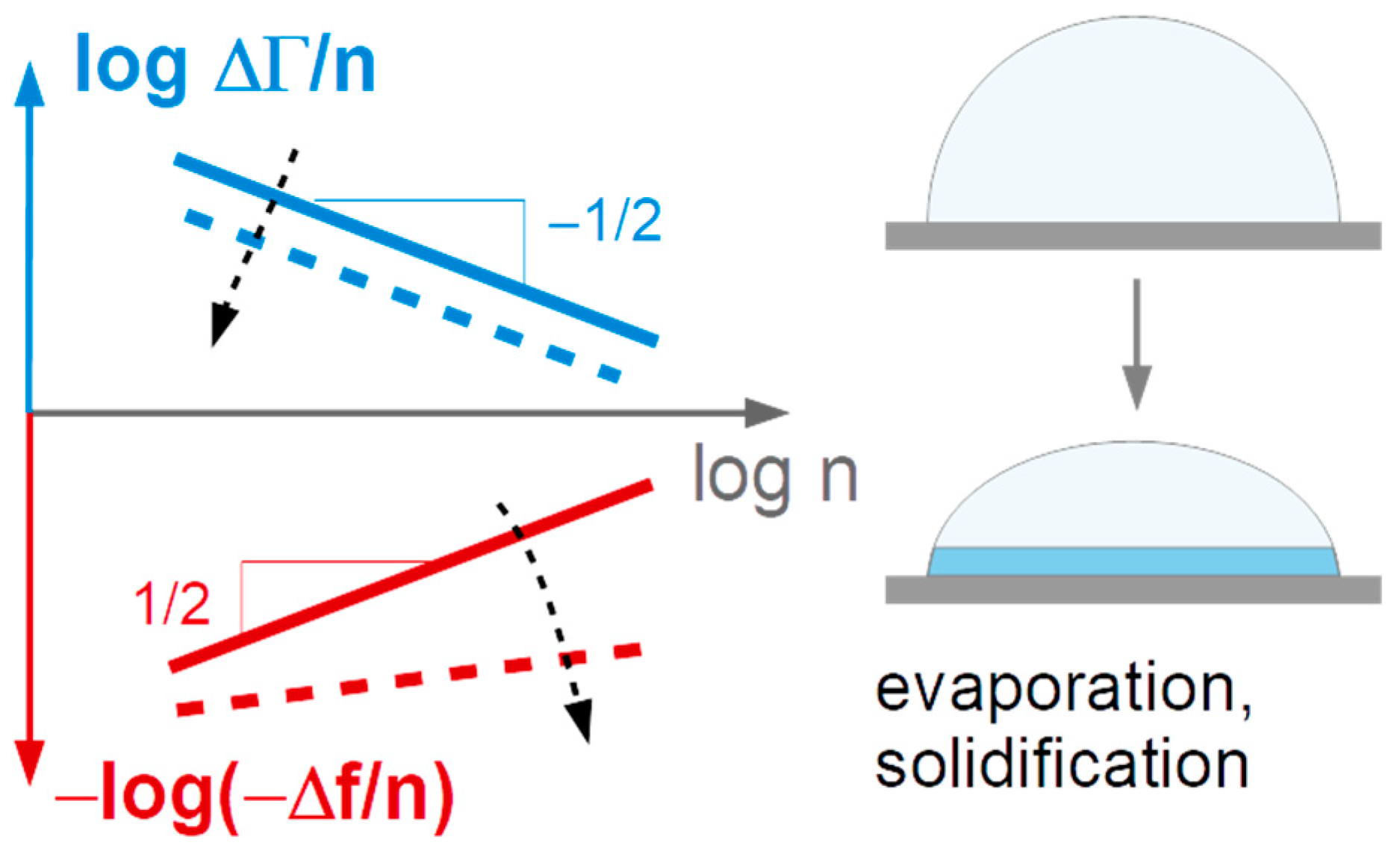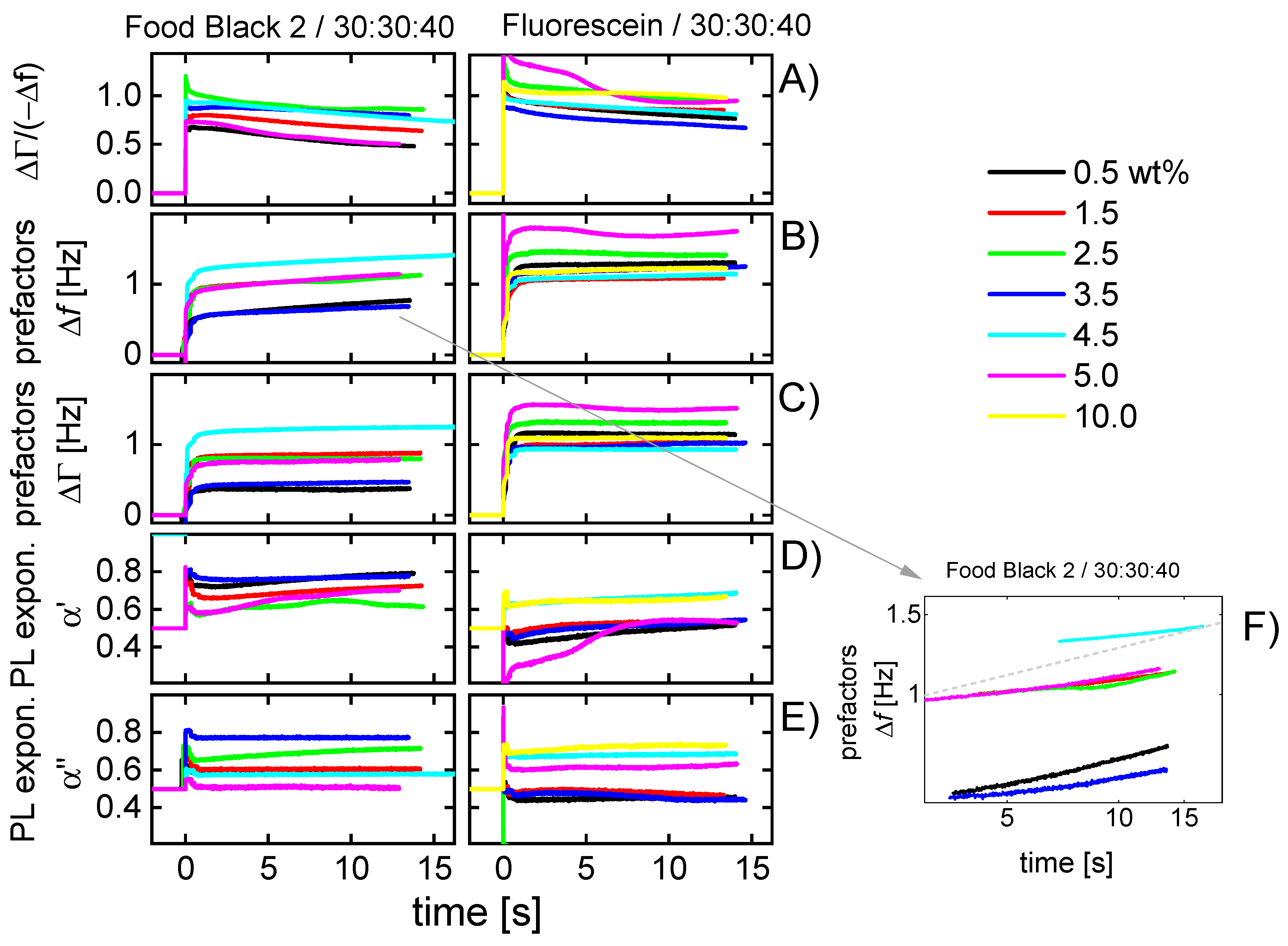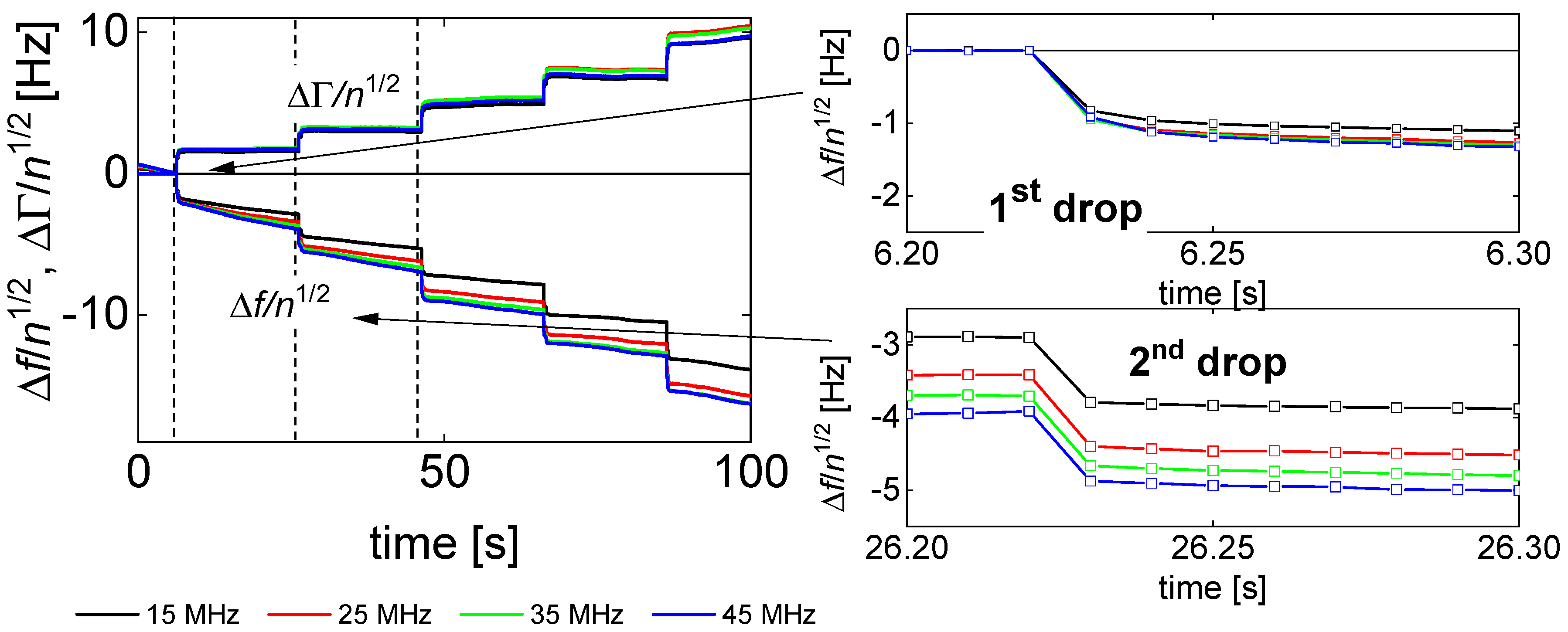A Quartz Crystal Microbalance, Which Tracks Four Overtones in Parallel with a Time Resolution of 10 Milliseconds: Application to Inkjet Printing
Abstract
:1. Introduction
2. General Remarks on the Response of the QCM to Loading with Droplets
- droplet weighing
- problems in the derivation of viscoelastic parameters caused by energy trapping
- the effects of capillarity
- compressional waves
- environmental effects
2.1. Droplet Weighing
2.2. Problems in the Derivation of Viscoelastic Parameters Caused by Variable Energy Trapping
2.3. Effects of Capillarity
2.4. Compressional Waves
2.5. Environmental Effects
3. Materials and Methods
3.1. Inkjet Printing
3.2. Quartz Crystall Microbalance (QCM)
3.3. Comb. Measurements
3.4. Data Processing and Interpretation
- Power laws are fitted to the functions −Δf and ΔΓ versus n:The prefactors AΔf and AΔΓ are related to the droplet area. The power-law exponents report intrinsic properties, independent of droplet size. There are two limiting cases. For the semi-infinite Newtonian liquid, one expects α′ = α″ = 1/2 (see Equation (1)). For solid films, one expects α′ = 1 and α″ = 0. Immediately after impact, we find α′ ≈ α″ ≈ 1/2. Deviations (which are present) may come about by energy trapping, by compressional waves, by capillarity, by relaxation processes with rates comparable to the frequency of vibration, and by the formation of a solid film at the substrate surface (see Figure 3).
4. Results and Discussions
- Variable conditions of droplet formation at the nozzle. The print head has 12 nozzles, which were actuated one after the other. Every droplet was a “first droplet” in the sense that the nozzle was dry. First droplets sometimes behave less reproducibly than droplets ejected after some running-in. The distance between two nozzles at the printer head was 250 µm. Due to evaporation inside the cartridge, the droplets may increase slightly in droplet mass (following slight increases in dye concentration).
- There may be differences in substrate microstructure and substrate wettability on the micro-scale. No attempts were made to avoid these.
- The amplitude distribution of the QCM often displays some irregular variability over the area of the plate. It goes back to defects in the crystal, which are not visible to the eye. An image is shown in Reference [66]. The local amplitude affects the magnitude of −Δf and ΔΓ.
- Apart from the small-scale variability in amplitude, there is a wafer-scale variability, often modeled as a Gaussian [67]. While the Gaussian is of influence, in principle, the total spread of droplet positions is 2.25 mm (corresponding to a line of 10 droplets, spaced by 250 µm). The length of this line is to be compared to the electrode radius of 3.5 mm. Presumably, the small-scale variability in amplitude (often disregarded) is more important than the Gaussian.
- −Δf and ΔΓ are about equal in magnitude. Equal magnitudes are expected for semi-infinite Newtonian liquids. These samples do not strongly deviate from this expectation.
- Data from different overtones overlap if they are divided by n1/2. Again, square-root-n-scaling is expected for the Newtonian liquid.
- The ratio ΔΓ/(−Δf) decreases, where the decrease is slightly stronger than average in the first few fractions of a second. Presumably, this initial decrease is related to microscale wetting.
- The results displayed in Figure 4E–H can be explained as follows:
- There are rather strong differences in the behavior of droplets printed from the liquid 30:30:40 (2-pyrrollidone: ethylene glycol: water) and droplets printed from aqueous solutions. These liquids mostly differ in the evaporation rate. A second difference is the viscosity, which is about a factor of 10 higher for the 30:30:40-liquid than for water.
- The droplets printed from aqueous solutions dry in less than 2 s. After drying, the bandwidth reverts to its original value. The frequency shift does not, because the dye remains on the substrate and acts as a Sauerbrey-type sample. The dye is moist, initially, and loses humidity later, as evidenced by a gradual increase in Δf.
- There is an interesting peculiarity for fluorescein in water (Figure 4G,H). For this sample, the bandwidth goes through a maximum shortly before returning to its base value before impact. This behavior would typically be associated with a film resonance, as sketched in Figure 7. If the three-phase line is pinned, the droplet will turn into a “pancake” while drying. When the height equals a quarter of the wavelength sound (about equal to the penetration depth of the shear wave, ~100 nm), the film itself is a resonator with a frequency equal to the frequency of the quartz crystal. At this point, the bandwidth goes through a sharp maximum and the frequency also shows a characteristic pattern. The drying kinetics shown Figure 4E,G suggest that the contact line is pinned for fluorescein, while it is not pinned for Food Black 2. This difference in phenomenology is seen for all 10 droplets, not just for the third droplet (the drying kinetics of which is displayed here.)
- ΔΓ/(−Δf) decreases not only in the first few 100 milliseconds (Figure 4B,D,F,H), the decrease continues slowly over the entire drying time.
- The power-law exponents of −Δf(n) (see Equation (4)) increase with time. Both the decrease in ΔΓ/(−Δf) (Figure 6A) and the increase in α′ (Figure 5D) can be explained by the formation of a solid film at the resonator surface as sketched in Figure 3. When a film forms at the substrate surface, this film adds a Sauerbrey-type contribution to the overall shifts of frequency and bandwidth. Accordingly, the bandwidth shifts become less pronounced compared to the frequency shift. The power-law exponent in fits of power laws to −Δf(n) shifts towards 1 (which is the exponent expected for dry films).
- The droplet area slowly increases over the entire drying time (Figure 5B,C). Figure 5F shows a log-log plot of AΔf versus time. The dashed line indicates the slope, which would be expected from Tanner’s law [26]. Tanner’s law states that the droplet radius should scale as t1/10, which implies that the droplet area scales as t1/5.
- The dependence of the drying kinetics on dye concentration is comparable in magnitude to the drop-to-drop variability. The respective graph has been moved to the supporting information (Figure S1). This is not meant to say that the observed variability (which includes the peculiar behavior of the 5%-sample) was not systematic. It might be systematic, but interpreting the limited amount of data shown in Figure 5 would amount to speculation.
5. Future Directions
- The droplet volume (160 pL) was on the large side as far as common technical procedures are concerned. The sensitivity would easily suffice to also study droplets with volumes of a few tens of pL. If sensitivity is a problem and if the droplet volumes should go down to a few pL, one may consider the use of HFF-resonators (high-frequency-fundamental-resonators) [7,68]. These consist of a thin quartz membrane in a thicker frame. The recess is created with reactive-ion etching. These resonators are exceptionally sensitive and they have a small active area. Overtones are not easily accessed, though. (Arcamone et al. have studied femtoliter droplets with a nanomechanical resonator [69], but such studies would not have been possible with a conventional QCM.)
- Smaller droplets would dry faster, and the benefits of the QCM-based measurement would play out stronger.
- Time resolution can be improved to about 100 µs with single-frequency measurements, as discussed in Reference [70]. Presumably, this would allow access to the time scale, where droplets oscillate in shape.
- Combination with a high-speed camera is worth consideration to study droplet impact and evolution on the surface with an independent method [71].
- It would be interesting to study textured or porous substrates. Those would have to be rigid and thinner than a few microns. Nonetheless, they can be applied to the QCM-surface as films by printing as well.
- Colloid-loaded droplets (see Figure S2 in the supporting information) will reveal details of the film formation process.
6. Conclusions
- a fast decrease in ΔΓ/(−Δf), indicative of microscale wetting, in general.
- a slow, further decrease in ΔΓ/(−Δf), paralleled by an increase in the power-law exponent of –Δf(n), which can be explained by the formation of a solid film at the resonator surface for the 30:30:40 samples.
- a slow, further spreading over a time scale of a few seconds, following Tanner’s law for the 30:30:40 samples.
Supplementary Materials
Author Contributions
Funding
Acknowledgments
Conflicts of Interest
References
- Steinem, C.; Janshoff, A. Piezoeletric Sensors; Springer: Heidelberg, Germany, 2007. [Google Scholar] [CrossRef]
- Rodahl, M.; Hook, F.; Krozer, A.; Brzezinski, P.; Kasemo, B. Quartz-Crystal Microbalance Setup for Frequency and Q-Factor Measurements in Gaseous and Liquid Environments. Rev. Sci. Instrum. 1995, 66, 3924–3930. [Google Scholar] [CrossRef] [Green Version]
- Lucklum, R.; Hauptmann, P. Acoustic microsensors-the challenge behind microgravimetry. Anal. Bioanal. Chem. 2006, 384, 667–682. [Google Scholar] [CrossRef]
- Johannsmann, D. Viscoelastic analysis of organic thin films on quartz resonators. Macromol. Chem. Phys. 1999, 200, 501–516. [Google Scholar] [CrossRef]
- Homola, J.; Yee, S.S.; Gauglitz, G. Surface plasmon resonance sensors: Review. Sens. Actuat. B-Chem. 1999, 54, 3–15. [Google Scholar] [CrossRef]
- Gileadi, E. Physical Electrochemistry: Fundamentals, Techniques and Applications; Wiley-VCH: Weinheim, Germany, 2011. [Google Scholar]
- Meyer, F.; Johannsmann, D.; Langhoff, A.; Reviakine, I. An Ultrafast Quartz Crystal Microbalance Based on A Frequency Comb Approach Delivers Sub-Millisecond Time Resolution. Rev. Sci. Instrum. 2019, 90, 115108. [Google Scholar] [CrossRef]
- Hutter, C.; Platz, D.; Tholen, E.A.; Hansson, T.H.; Haviland, D.B. Reconstructing Nonlinearities with Intermodulation Spectroscopy. Phys. Rev. Lett. 2010, 104, 050801. [Google Scholar] [CrossRef] [Green Version]
- Beck, R.; Pittermann, U.; Weil, K.G. Impedance Analysis of Quartz Oscillators, Contacted on One Side with a Liquid. Ber. Bunsenges. Phys. Chem. 1988, 92, 1363–1368. [Google Scholar] [CrossRef]
- Ballato, A.; Tilton, R. Electronic Activity Dip Measurement. IEEE Trans. Instrum. Meas. 1978, IM-27, 59. [Google Scholar] [CrossRef]
- Vig, J.R. Dual-mode oscillators for clocks and sensors. In Proceedings of the 1999 IEEE Ultrasonics Symposium. Proceedings. International Symposium (Cat. No.99CH37027), Caesars Tahoe, NV, USA, 17–20 October 1999; Volume 2, pp. 859–868. [Google Scholar]
- Alassi, A.; Benammar, M.; Brett, D. Quartz Crystal Microbalance Electronic Interfacing Systems: A Review. Sensors 2017, 17, E2799. [Google Scholar] [CrossRef] [Green Version]
- Ferrari, M.; Ferrari, V. An oscillator circuit for dual-harmonic tracking of frequency and resistance in quartz resonator sensors. Meas. Sci. Technol. 2009, 20, 124005. [Google Scholar] [CrossRef]
- Lin, Z.X.; Hill, R.M.; Davis, H.T.; Ward, M.D. Determination of Wetting Velocities of Surfactant Superspreaders with the Quartz-Crystal Microbalance. Langmuir 1994, 10, 4060–4068. [Google Scholar] [CrossRef]
- Baek, S.; Kim, W.; Jeon, S.; Yong, K. Developing a non-optical platform for impact dynamics analysis on nanostructured superhydrophobic surfaces using a quartz crystal microbalance. Sens. Actuat. B-Chem. 2018, 262, 595–602. [Google Scholar] [CrossRef]
- Wang, P.T.; Su, J.W.; Shen, M.Y.; Ruths, M.; Sun, H.W. Detection of Liquid Penetration of a Micropillar Surface Using the Quartz Crystal Microbalance. Langmuir 2017, 33, 638–644. [Google Scholar] [CrossRef]
- Pham, N.T.; McHale, G.; Newton, M.I.; Carroll, B.J.; Rowan, S.M. Application of the quartz crystal microbalance to the evaporation of colloidal suspension droplets. Langmuir 2004, 20, 841–847. [Google Scholar] [CrossRef]
- Joyce, M.J.; Todaro, P.; Penfold, R.; Port, S.N.; May, J.A.W.; Barnes, C.; Peyton, A.J. Evaporation of sessile drops: Application of the quartz crystal microbalance. Langmuir 2000, 16, 4024–4033. [Google Scholar] [CrossRef]
- Couturier, G.; Vatinel, S.; Boisgard, R.; Aime, J.P.; Chabli, A. Quartz crystal microbalance and evaporation of sessile droplets. J. Appl. Phys. 2009, 106, 4. [Google Scholar] [CrossRef]
- Prasad, A.; Lin, A.T.H.; Rao, V.R.; Seshia, A.A. Monitoring sessile droplet evaporation on a micromechanical device. Analyst 2014, 139, 5538–5546. [Google Scholar] [CrossRef] [Green Version]
- Fuh, J.Y.H.; Sun, J.; Li, E.Q.; Li, J.; Chang, L.; Hong, G.S.; Wong, Y.S.; Thian, E.S. Micro- and Bio-Rapid Prototyping Using Drop-On-Demand 3D Printing. In Handbook of Manufacturing Engineering and Technology; Nee, A., Ed.; Springer: London, UK, 2014; pp. 2567–2583. [Google Scholar]
- Graham, A.D.; Olof, S.N.; Burke, M.J.; Armstrong, J.P.K.; Mikhailova, E.A.; Nicholson, J.G.; Box, S.J.; Szele, F.G.; Perriman, A.W.; Bayley, H. High-Resolution Patterned Cellular Constructs by Droplet-Based 3D Printing. Sci. Rep. 2017, 7. [Google Scholar] [CrossRef]
- Haeberle, S.; Zengerle, R. Microfluidic platforms for lab-on-a-chip applications. Lab. Chip. 2007, 7, 1094–1110. [Google Scholar] [CrossRef]
- Hauschild, S. Dissertation, Herstellung von Kolloidalen Dispersionen und Oberflächenbeschichtungen mit Tintendruckern; University of Hamburg: Hamburg, Germany, 2009. [Google Scholar]
- Yao, L.; Ou, J.; Wang, G.; Cheng, C.Y.; Wang, W.; Steiner, H.; Ishii, H. bioPrint: A Liquid Deposition Printing System for Natural Actuators. 3D Print. Addit. Manuf. 2015, 2, 168–179. [Google Scholar] [CrossRef] [Green Version]
- Derby, B. Inkjet Printing of Functional and Structural Materials: Fluid Property Requirements, Feature Stability, and Resolution. Annu. Rev. Mater. Res. 2010, 40, 395–414. [Google Scholar] [CrossRef]
- Tanner, L.H. Spreading of Silicone Oil Drops on Horizontal Surfaces. J. Phys. D Appl. Phys. 1979, 12, 1473–1484. [Google Scholar] [CrossRef]
- Routh, A.F.; Russel, W.B. Deformation mechanisms during latex film formation: Experimental evidence. Ind. Eng. Chem. Res. 2001, 40, 4302–4308. [Google Scholar] [CrossRef]
- Kamyshny, A.; Magdassi, S. Inkjet Ink Formulations. In Inkjet-Based Micromanufacturing; Korvink, J.G., Smith, P.J., Shin, D.-Y., Eds.; Wiley-VCH: Weinheim, Germany, 2012. [Google Scholar]
- Tobjork, D.; Osterbacka, R. Paper Electronics. Adv. Mater. 2011, 23, 1935–1961. [Google Scholar] [CrossRef]
- Keddie, J.L. Film formation of latex. Mater. Sci. Eng. R Rep. 1997, 21, 101–170. [Google Scholar] [CrossRef]
- Deegan, R.D.; Bakajin, O.; Dupont, T.F.; Huber, G.; Nagel, S.R.; Witten, T.A. Contact line deposits in an evaporating drop. Phys. Rev. E 2000, 62, 756–765. [Google Scholar] [CrossRef] [Green Version]
- Fittschen, U.E.A.; Bings, N.H.; Hauschild, S.; Förster, S.; Kiera, A.F.; Kravani, E.; Frömsdorf, A.; Thiele, J.; Falkenberg, G. Characteristics of Picoliter Droplet Dried Residues as Standards for Direct Analysis Techniques. Anal. Chem. 2008, 80, 1967–1977. [Google Scholar] [CrossRef]
- Bings, N.H.; Orlandi, V.; Niessen, J.O.; Schaper, J.N. Liquid sample introduction in inductively coupled plasma atomic emission and mass spectrometry—Critical review. Spectrochim. Acta B 2014, 100, 14–37. [Google Scholar] [CrossRef]
- Gschwind, S.; Flamigni, L.; Koch, J.; Borovinskaya, O.; Groh, S.; Niemax, K.; Günther, D. Capabilities of inductively coupled plasma mass spectrometry for the detection of nanoparticles carried by monodisperse microdroplets. J. Anal. At. Spectrom. 2011, 26, 1166–1174. [Google Scholar] [CrossRef]
- Verboket, P.E.; Borovinskaya, O.; Meyer, N.; Günther, D.; Dittrich, P.S. A new microfluidics-based droplet dispenser for ICPMS. Anal. Chem. 2014, 86, 6012–6018. [Google Scholar] [CrossRef]
- Fittschen, U.E.A.; Hauschild, S.; Amberger, M.A.; Lammel, G.; Streli, C.; Förster, S.; Wobrauscheck, P.; Jakubonis, C.; Pepponi, G.; Falkenberg, G.; et al. A new technique for the deposition of standard solutions in total reflection X-ray fluorescence spectrometry (TXRF) using pico-droplets generated by inkjet printers and its applicability for aerosol analysis with SR-TXRF. Spectrochim. Acta B 2006, 61, 1098–1104. [Google Scholar] [CrossRef]
- Sparks, C.M.; Fittschen, U.A.E.; Havrilla, G.J. Picoliter solution deposition for total reflection X-ray fluorescence analysis of semiconductor samples. Spectrochim. Acta B 2010, 65, 805–811. [Google Scholar] [CrossRef]
- Sparks, C.M.; Fittschen, U.E.A.; Havrilla, G.J. Investigation of total reflection X-ray fluorescence calibration with picoliter deposition arrays. Microelectron. Eng. 2013, 102, 98–102. [Google Scholar] [CrossRef]
- Fittschen, U.A.E.; Havrilla, G.J. Picoliter Droplet Deposition Using a Prototype Picoliter Pipette: Control Parameters and Application in Micro X-ray Fluorescence. Reference-Free Total Reflection X-ray Fluorescence Analysis of Semiconductor Surfaces with Synchrotron Radiation. Anal. Chem. 2009, 82, 297–306. [Google Scholar] [CrossRef]
- Fittschen, U.E.A.; Menzel, M.; Scharf, O.; Radtke, M.; Reinholz, U.; Buzanich, G.; Lopez, V.M.; McIntosh, K.; Streli, C.; Havrilla, G.J. Observation of X-ray shadings in synchrotron radiation-total reflection X-ray fluorescence using a color X-ray camera. Spectrochim. Acta B 2014, 99, 179–184. [Google Scholar] [CrossRef]
- Kulow, A.; Buzanich, A.G.; Reinholz, U.; Emmerling, F.; Hampel, S.; Fittschen, U.E.A.; Streli, C.; Radtke, M. Comparison of three reconstruction methods based on deconvolution, iterative algorithm and neural network for X-ray fluorescence imaging with coded aperture optics. J. Anal. At. Spectrom. 2020, 35, 1423–1434. [Google Scholar] [CrossRef]
- Hampel, S. Charakterisierung von “Drop on Demand” Picoliter Tropfen für den Einsatz in der Totalreflexionsröntgenfluoreszenzanalyse. Master’s Thesis, Clausthal University of Technology, Clausthal-Zellerfeld, Germany, 2019. [Google Scholar]
- Kuzelinis, F.; Petersen, J.H.; Weis, P.; Bings, N.H. Calibration of LA-ICP-MS via standard addition using dried picoliter droplets. J. Anal. At. Spectrom. 2020, 35, 1922–1931. [Google Scholar] [CrossRef]
- Orlandini, V.; Niessen, J.O.; Schaper, J.N.; Petersen, J.H.; Bings, N.H. Development and characterization of a thermal inkjet-based aerosol generator for micro-volume sample introduction in analytical atomic spectrometry. J. Anal. At. Spectrom. 2011, 26, 1781–1789. [Google Scholar] [CrossRef]
- Fuchiwaki, Y.; Tanaka, M.; Makita, Y.; Ooie, T. New Approach to a Practical Quartz Crystal Microbalance Sensor Utilizing an Inkjet Printing System. Sensors 2014, 14, 20468–20479. [Google Scholar] [CrossRef] [Green Version]
- Sauerbrey, G. Verwendung von Schwingquarzen zur Wägung Dünner Schichten und zur Mikrowägung. Z. Phys. 1959, 155, 206–222. [Google Scholar] [CrossRef]
- Lazarowich, R.J.; Taborek, P.; Yoo, B.Y.; Myung, N.V. Fabrication of porous alumina on quartz crystal microbalances. J. Appl. Phys. 2007, 101, 104909. [Google Scholar] [CrossRef] [Green Version]
- Liang, D.; Zhang, J.; Govindaiah, M.T.; Tanguy, L.; Ernst, A.; Zengerle, R.; Koltay, P. Liquid volume measurement method for the picoliter to nanoliter volume range based on quartz crystal microbalance technology. Meas. Sci. Technol. 2014, 25, 095302. [Google Scholar] [CrossRef]
- Verkouteren, R.M.; Verkouteren, J.R. Inkjet Metrology: High-Accuracy Mass Measurements of Microdroplets Produced by a Drop-on-Demand Dispenser. Anal. Chem. 2009, 81, 8577–8584. [Google Scholar] [CrossRef] [Green Version]
- Kanazawa, K.K.; Gordon, J.G. Frequency of a Quartz Microbalance in Contact with Liquid. Anal. Chem. 1985, 57, 1770–1771. [Google Scholar] [CrossRef]
- Rodahl, M.; Kasemo, B. Frequency and dissipation-factor responses to localized liquid deposits on a QCM electrode. Sensor. Actuat. B-Chem. 1996, 37, 111–116. [Google Scholar] [CrossRef]
- Flanigan, C.M.; Desai, M.; Shull, K.R. Contact mechanics studies with the quartz crystal microbalance. Langmuir 2000, 16, 9825–9829. [Google Scholar] [CrossRef]
- Ash, D.C.; Joyce, M.J.; Barnes, C.; Booth, C.J.; Jefferies, A.C. Viscosity measurement of industrial oils using the droplet quartz crystal microbalance. Meas. Sci. Technol. 2003, 14, 1955–1962. [Google Scholar] [CrossRef]
- Herrscher, M.; Ziegler, C.; Johannsmann, D. Shifts of frequency and bandwidth of quartz crystal resonators coated with samples of finite lateral size. J. Appl. Phys. 2007, 101, 114909. [Google Scholar] [CrossRef]
- Mindlin, R.D.; Deresiewicz, H. Thickness-Shear Vibrations of Piezoelectric Crystal Plates with Incomplete Electrodes. J. Appl Phys. 1954, 25, 21–24. [Google Scholar] [CrossRef]
- Finger, A.; Johannsmann, D. Hemispherical nanobubbles reduce interfacial slippage in simple liquids. Phys. Chem. Chem. Phys. 2011, 13, 18015–18022. [Google Scholar] [CrossRef] [Green Version]
- McKenna, L.; Newton, M.I.; McHale, G.; Lucklum, R.; Schroeder, J. Compressional acoustic wave generation in microdroplets of water in contact with quartz crystal resonators. J. Appl. Phys. 2001, 89, 676–680. [Google Scholar] [CrossRef]
- Lin, Z.X.; Ward, M.D. The Role of Longitudinal-Waves in Quartz-Crystal Microbalance Applications in Liquids. Anal. Chem. 1995, 67, 685–693. [Google Scholar] [CrossRef]
- HP Inc. HP Extended TIJ 1.0 Print Cartridges Datasheet; HP Inc.: Palo Alto, CA, USA, 2003. [Google Scholar]
- Nielsen, N. History of ThinkJet Printhead Development. Hewlett-Packard J. 1985, 1985, 4–10. [Google Scholar]
- Available online: https://reprap.org/wiki/Inkshield (accessed on 24 February 2020).
- Shekaari, H.; Zafarani-Moattar, M.T.; Mirheydari, S.N. Effect of 1-Butyl-3-methylimidazolium Ibuprofenate as an Active Pharmaceutical Ingredient Ionic Liquid (API-IL) on the Thermodynamic Properties of Glycine and l-Alanine in Aqueous Solutions at Different Temperatures. J. Solut. Chem. 2016, 45, 624–663. [Google Scholar] [CrossRef]
- Farhan, A.M.; Awwad, A.M. Densities, Viscosities, and Excess Molar Enthalpies of 2-Pyrrolidone + Butanol Isomers at T = (293.15, 298.15, and 303.15) K. J. Chem. Eng. 2009, 54, 2095–2099. [Google Scholar] [CrossRef]
- Sun, S.; Niu, Y.; Fei, G.; Shen, J.; Wei, X. Solubility Properties and Spectral Characterization of Dilute SO2 in Binary Mixtures of Urea + Ethylene Glycol. J. Chem. Eng. 2015, 60, 161–170. [Google Scholar] [CrossRef]
- Hess, C.; Borgwarth, K.; Heinze, J. Integration of an electrochemical quartz crystal microbalance into a scanning electrochemical microscope for mechanistic studies of surface patterning reactions. Electrochim. Acta 2000, 45, 3725–3736. [Google Scholar] [CrossRef]
- Ma, T.F.; Zhang, C.; Jiang, X.N.; Feng, G.P. Thickness shear mode quartz crystal resonators with optimized elliptical electrodes. Chin. Phys. B 2011, 20, 047701. [Google Scholar] [CrossRef] [Green Version]
- Guttwein, G.K.; Ballato, A.D.; Lukaszek, T.J. VHF-UHF Piezoelectric Resonators. U.S. Patent 3694677, 26 September 1972. [Google Scholar]
- Arcamone, J.; Dujardin, E.; Rius, G.; Perez-Murano, F.; Ondarcuhu, T. Evaporation of femtoliter sessile droplets monitored with nanomechanical mass sensors. J. Phys. Chem. B 2007, 111, 13020–13027. [Google Scholar] [CrossRef]
- Leppin, C.; Peschel, A.; Meyer, F.; Langhoff, A.; Johannsmann, D. Dynamics of Charge Reversal and Viscosity in the Electric Double Layer Studied by a Fast Electrochemical Quartz Crystal Microbalance (EQCM). Analyst 2020. Submitted. [Google Scholar]
- Visser, C.W.; Tagawa, Y.; Sun, C.; Lohse, D. Microdroplet impact at very high velocity. Soft Matter 2012, 8, 10732–10737. [Google Scholar] [CrossRef] [Green Version]







Publisher’s Note: MDPI stays neutral with regard to jurisdictional claims in published maps and institutional affiliations. |
© 2020 by the authors. Licensee MDPI, Basel, Switzerland. This article is an open access article distributed under the terms and conditions of the Creative Commons Attribution (CC BY) license (http://creativecommons.org/licenses/by/4.0/).
Share and Cite
Leppin, C.; Hampel, S.; Meyer, F.S.; Langhoff, A.; Fittschen, U.E.A.; Johannsmann, D. A Quartz Crystal Microbalance, Which Tracks Four Overtones in Parallel with a Time Resolution of 10 Milliseconds: Application to Inkjet Printing. Sensors 2020, 20, 5915. https://doi.org/10.3390/s20205915
Leppin C, Hampel S, Meyer FS, Langhoff A, Fittschen UEA, Johannsmann D. A Quartz Crystal Microbalance, Which Tracks Four Overtones in Parallel with a Time Resolution of 10 Milliseconds: Application to Inkjet Printing. Sensors. 2020; 20(20):5915. https://doi.org/10.3390/s20205915
Chicago/Turabian StyleLeppin, Christian, Sven Hampel, Frederick Sebastian Meyer, Arne Langhoff, Ursula Elisabeth Adriane Fittschen, and Diethelm Johannsmann. 2020. "A Quartz Crystal Microbalance, Which Tracks Four Overtones in Parallel with a Time Resolution of 10 Milliseconds: Application to Inkjet Printing" Sensors 20, no. 20: 5915. https://doi.org/10.3390/s20205915
APA StyleLeppin, C., Hampel, S., Meyer, F. S., Langhoff, A., Fittschen, U. E. A., & Johannsmann, D. (2020). A Quartz Crystal Microbalance, Which Tracks Four Overtones in Parallel with a Time Resolution of 10 Milliseconds: Application to Inkjet Printing. Sensors, 20(20), 5915. https://doi.org/10.3390/s20205915





